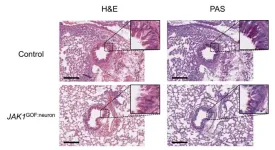(Press-News.org) Dec. 21, 2023
Contact: Nicole Casal Moore, 734-709-1651, ncmoore@umich.edu
Images and videos
Better prosthetics: $3M to develop more natural robotic leg control
An effort to create a control model that moves seamlessly between different activities like standing, walking and climbing stairs is renewed by the National Institutes of Health
ANN ARBOR—A smoother experience for robotic prosthetic leg users is the aim of a University of Michigan project that has received renewed support from the National Institutes of Health. The R01 grant of $3 million will also enable the implementation of the researchers' improved control program on a commercially available robotic prosthetic leg.
Sit to stand, stand to walk, up and down stairs and inclines—the human body shifts among these activities almost thoughtlessly. But these transitions are hard for robots, and robotic prosthetic legs have the additional challenge of not being hooked into the human user’s central nervous system to stay synchronized with their body.
Working on the problem since 2013, principal investigator Robert Gregg, an associate professor of robotics, saw early success controlling the position of the knee and ankle joints through a model that continuously represents all stages of the gait cycle. Previously, robotic prosthetic legs used separate controllers for each stage in the gait cycle like the heel strike, push-off and swing. As a result, the control parameters for each model and rules for switching from one model to another had to be optimized for each patient.
"Every person has different parameters because every person walks differently. And that resulted in very, very cumbersome clinical deployment," Gregg said.
Using the motion of the thigh to predict joint position with a continuous model turned out to be a pretty good way of creating a natural gait. With the initial R01 grant in 2018, Gregg's team extended the walking control model to cover other important scenarios: inclines, stairs, sit-to-stand and stand-to-walk. Study participants could do all of these activities with more typical biomechanics using the robotic leg than they could with passive prosthetics. However, pinning the control algorithm to joint angles leads to a more rigid experience when trying to change activities.
"The robot has very strong motors, and so, if you're controlling the position and it's somehow incompatible with the environment, it can feel very rigid and jarring," he said, which can mean pain for amputees where the limb meets the socket.
So Gregg's team is now looking at controlling joint position indirectly—mimicking biomechanical impedance instead—using their continuous modeling framework. With an impedance approach, there's an equilibrium position, and the forces are set to gently pull the joint back into that position if it's disturbed. This provides some wiggle room.
Gregg compares it to suspension on a car. "You have the spring, and then you have a shock-absorbing mechanism. You want to hit the pothole and have enough bounce to soften the jolt, but you don't want to oscillate forever."
This should enable the leg to offer the same ability to seamlessly move from one activity to another while also providing a cushier ride.
The programming of the leg is based on biomechanical measurements of people with two biological legs, in an effort to replicate the motion that the hips and back evolved for. Users of passive prosthetic legs often experience pain in the hips, back and organic knee due to the way they need to compensate for the dead weight of the prosthetic leg.
To learn how the leg should behave across activities, Gregg united with collaborator Elliott Rouse, who studies the mechanical properties of healthy human gait.
"We obtain the measurements for determining the biomechanical properties of the leg using an exoskeleton," said Rouse, associate professor of robotics and mechanical engineering, and co-investigator on the project. "The exoskeleton mostly provides no assistance but occasionally applies a quick perturbation that displaces the limb. From these measurements, we can determine the mechanical impedance, including properties like stiffness, viscosity and inertia."
The control programs will first be tested on the robotic leg that Gregg's team built in-house, with motors to power both the ankle and knee. Then, to see if the new algorithms are ready to start helping people now, the team will test them on Ossür's Power Knee prosthetic leg. In addition to measuring the biomechanics of study participants as they walk with the prosthetic legs, the team will collect formal feedback to quantify increases in comfort and reductions in pain.
The Power Knee has a springy, passive ankle with a smaller range of motion, but it is also lighter than the lab leg—and most importantly, it is helping people walk now. Gregg's team is confident that they can modify their control model to work on it, perhaps improving on the models Ossür is currently running.
Jeff Wensman, clinical collaborator from the U-M Orthotics and Prosthetics Center, is also a co-investigator of the project. Gregg is also an associate professor of electrical and computer engineering and mechanical engineering.
Project: Controlling locomotion over continuously varying activities for agile powered prosthetic legs
Written by Kate McAlpine
END
Better prosthetics: $3M to develop more natural robotic leg control
An effort to create a control model that moves seamlessly between different activities like standing, walking and climbing stairs is renewed by the National Institutes of Health
2023-12-21
ELSE PRESS RELEASES FROM THIS DATE:
The Council of Medical Specialty Societies awards CHEST a $100,000 grant to improve diagnostic excellence in ILD
2023-12-21
Glenview, IL – The American College of Chest Physicians (CHEST) was awarded a $100,000 grant from the Council of Medical Specialty Societies (CMSS) to improve diagnostic excellence in interstitial lung disease (ILD).
The funded project, called, "'How We Do It': CHEST Experts Weigh In," aims to inform future best practices in reducing the time to diagnosis for ILDs. The activities in the series will prepare the learner to:
define symptoms and patient profiles associated with ILD;
recognize health inequities that may assist in the diagnosis of ILD;
identify the appropriate tests that may help validate a suspicion of ILD; ...
Center for BrainHealth investigates the impact of auditory beat stimulation on cognition
2023-12-21
Certain Frequencies Enhance Comprehension
New research conducted by the Center for BrainHealth at The University of Texas at Dallas investigates the impact of binaural beat (BB) on language skills. BB is a sound that occurs when two slightly mismatched pure tones are heard. There is a growing interest in using BB as a non-invasive neuromodulation to enhance cognitive performance.
The study, Neural consequences of binaural beat stimulation on auditory sentence comprehension: an EEG study, was recently published in Cerebral Cortex.
Led by researchers in the Speech, Language and Music (SLAM) Lab, this EEG ...
Where you live matters: A first-of-its-kind study illustrates how racism is interrelated with poor health
2023-12-21
Where You Live Matters: A First-of-Its-Kind Study Illustrates How Racism Is Interrelated With Poor Health
Study published in JAMA Network Open points to discrete factors, like voting participation, employment, education, and housing, that may serve as promising targets for interventions
New York, NY (December 21, 2023) – A team of health equity researchers from several institutions has leveraged a complex web of data to test a hypothesis: That structural racism is associated with resources and structures at the neighborhood level that are closely associated with poor health. What they found in an analysis of highly localized, ...
New tool unifies single-cell data
2023-12-21
A new methodology that allows for the categorisation and organisation of single-cell data has been launched. It can be used to create a harmonised dataset for the study of human health and disease.
Researchers at the Wellcome Sanger Institute, the University of Cambridge, EMBL’s European Bioinformatics Institute (EMBL-EBI), and collaborators developed the tool, known as CellHint. CellHint uses machine learning to unify data produced across the world, allowing it to be accessed by the wider research community, potentially driving new discoveries.
In a new study, ...
Pancake stack of films on a balloon most accurate gamma-ray telescope
2023-12-21
A pancake stack of radioactivity-sensitive films carried through the sky by a balloon was able to take the world's most accurate picture of a neutron star's gamma ray beam. To achieve this, Kobe University researchers combined the oldest method of capturing radioactive radiation with the newest data capturing techniques and a clever time-recording device.
The stars shine their light on us in the full range of the spectrum of light, from infra-red to gamma rays. For each of these bands, different sensing equipment is needed. The most challenging one is gamma rays, famous for being a high-energy product of nuclear fission, ...
Wireless tracking system could help improve the XR experience
2023-12-21
A new technology developed by engineers at the University of California San Diego has the potential to make the extended reality (XR) experience smoother and more seamless. The technology consists of an asset localization system that uses wireless signals to track physical objects with centimeter-level accuracy in real time, and then generates a virtual representation of these objects. Applications of this technology range from enhancing virtual gaming experiences to improving workplace safety.
The team, led by Dinesh Bharadia, a professor in the Department of Electrical and Computer Engineering at the UC San Diego Jacobs School of Engineering, ...
Fleeing drought, vulnerable populations face flood risk in most African countries
2023-12-21
American Geophysical Union
Press Release 23-47
21 December 2023
For Immediate Release
This press release is also available online at: https://news.agu.org/press-release/fleeing-drought-vulnerable-populations-face-flood-risk-in-most-african-countries
AGU press contact:
Liza Lester, +1 (202) 777-7494, news@agu.org (UTC-5 hours)
Contact information for the researchers:
Serena Ceola, University of Bologna, serena.ceola@unibo.it (GMT+1 hours)
WASHINGTON — In 80% of African countries, moved toward rivers and into cities during or following drought, increasing the number of people living in flood-risk areas in ...
The future of canine stem cell therapy: unprecedented, painless, and feeder-free
2023-12-21
Osaka, Japan – Dog owners may need to learn to appreciate their best friend’s urine. Scientists at Osaka Metropolitan University have devised an efficient, non-invasive, and pain-free method to reprogram canine stem cells from urine samples, bringing furry companions one step closer to veterinary regenerative treatment.
Induced pluripotent stem cells (iPSCs) have been widely employed in studies on human generative medicine. With the growing importance of advanced medical care for dogs and cats, there is an expectation that new therapies utilizing iPSCs will ...
New insights revealed on tissue-dependent roles of JAK signaling in inflammation
2023-12-21
Researchers at the Icahn School of Medicine at Mount Sinai have gained a deeper understanding of the nuanced roles of JAK inhibitors, or modulators, in inflammation across various cell types and tissues. Their findings suggest a more precise approach is required to potentially expand JAK inhibitor use to a wider range of allergy and inflammatory disorders. Details on the findings were published in the December 21, 2023, issue of the journal Cell.
JAK1 is a key protein in the body that supports cell communication and controls the immune system. It is part of ...
Researchers discover key to epithelial cell growth
2023-12-21
RESEARCHERS DISCOVER KEY TO EPITHELIAL CELL GROWTH
Australian researchers have discovered a new way that epithelial cells, which form layers in organs like the skin and stomach, attach to one another, and how they perceive growth signals at these attachments, helping them form tissues of the right size and shape.
Epithelial cells cover the surfaces of most organs in the body and must adhere to each other to form both a protective and permeable barrier. They are exquisitely designed to both be tightly sealed against pathogens like bacteria, and to also allow the transport of salts, fluids, and nutrients.
Researchers, led by Professor Kieran Harvey and Dr Benjamin Kroeger, at the ...
LAST 30 PRESS RELEASES:
Injectable breast ‘implant’ offers alternative to traditional surgeries
Neuroscientists devise formulas to measure multilingualism
New prostate cancer trial seeks to reduce toxicity without sacrificing efficacy
Geometry shapes life
A CRISPR screen reveals many previously unrecognized genes required for brain development and a new neurodevelopmental disorder
Hot flush treatment has anti-breast cancer activity, study finds
Securing AI systems against growing cybersecurity threats
Longest observation of an active solar region
Why nail-biting, procrastination and other self-sabotaging behaviors are rooted in survival instincts
Regional variations in mechanical properties of porcine leptomeninges
Artificial empathy in therapy and healthcare: advancements in interpersonal interaction technologies
Why some brains switch gears more efficiently than others
UVA’s Jundong Li wins ICDM’S 2025 Tao Li Award for data mining, machine learning
UVA’s low-power, high-performance computer power player Mircea Stan earns National Academy of Inventors fellowship
Not playing by the rules: USU researcher explores filamentous algae dynamics in rivers
Do our body clocks influence our risk of dementia?
Anthropologists offer new evidence of bipedalism in long-debated fossil discovery
Safer receipt paper from wood
Dosage-sensitive genes suggest no whole-genome duplications in ancestral angiosperm
First ancient human herpesvirus genomes document their deep history with humans
Why Some Bacteria Survive Antibiotics and How to Stop Them - New study reveals that bacteria can survive antibiotic treatment through two fundamentally different “shutdown modes”
UCLA study links scar healing to dangerous placenta condition
CHANGE-seq-BE finds off-target changes in the genome from base editors
The Journal of Nuclear Medicine Ahead-of-Print Tip Sheet: January 2, 2026
Delayed or absent first dose of measles, mumps, and rubella vaccination
Trends in US preterm birth rates by household income and race and ethnicity
Study identifies potential biomarker linked to progression and brain inflammation in multiple sclerosis
Many mothers in Norway do not show up for postnatal check-ups
Researchers want to find out why quick clay is so unstable
Superradiant spins show teamwork at the quantum scale
[Press-News.org] Better prosthetics: $3M to develop more natural robotic leg controlAn effort to create a control model that moves seamlessly between different activities like standing, walking and climbing stairs is renewed by the National Institutes of Health



